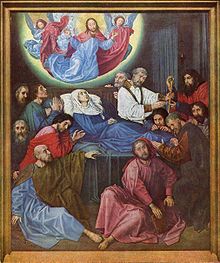- Death of the Virgin
-
 Hugo van der Goes, ca. 1480
Hugo van der Goes, ca. 1480
The Death of the Virgin Mary is a common theme in Western Christian art, comparable to the Dormition in Eastern Orthodox art. It becomes less common as the doctrine of the Assumption gains support in the Roman Catholic Church from the late Middle Ages onwards. Although that doctrine avoids stating whether Mary was alive or dead when she was bodily taken up to Heaven, she is normally shown in art as alive. A tradition[1][2] says the twelve Apostles were miraculously assembled from their far-flung missionary activity to be present at the death, and that is the scene normally depicted, with the apostles gathered round the bed. A virtuoso engraving by Martin Schongauer influences most later depictions.[3] Earlier depictions usually follow the standard Byzantine image, with the Virgin lying on a simple bed across the front of the picture space.
A prominent, and late, example of the subject is Death of the Virgin by Caravaggio (1606), the last major Catholic depiction.
References
- ^ Jameson, Anna (2010-04-22). Legends of the Madonna: As Represented in the Fine Arts. Forgotten Books. ISBN 1440085617.
- ^ Pascale, Enrico De; J. Paul Getty Museum (2009-03). Death and resurrection in art. Getty Publications. ISBN 9780892369478.
- ^ "Réunion des musées nationaux". http://www.photo.rmn.fr/c/htm/CSearchZ.aspx?o=&Total=31&FP=77900057&E=22S39UW3N4QEA&SID=22S39UW3N4QEA&New=T&Pic=1&SubE=2C6NU0GBL7G9. Retrieved 2011-10-01.
External links
- "The Assumption". http://campus.udayton.edu/mary/resources/theassumption.html. Retrieved 2011-10-01.
Categories:- Art history stubs
- Saint stubs
- Depictions of the Virgin Mary
- Christian death-related art
Wikimedia Foundation. 2010.
